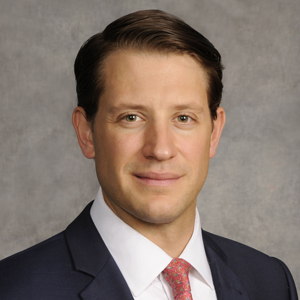
Karen Hiatt, CFA, is a Senior Portfolio Manager, a Managing Director and CIO Focused Growth Equities with Allianz Global Investors, which she joined in 1998. She manages all focused-growth strategies. Earlier, Ms. Hiatt was a senior research analyst, sector head of the U.S. consumer team and U.S. Director of Research. She has 22 years of investment-industry experience. Ms. Hiatt was previously a vice president and analyst at Bioscience Securities, a boutique investment bank. She has a B.S. in finance, cum laude, from Santa Clara University. In her exclusive interview with the Wall Street Transcript, Ms. Hiatt explains her investment methodology:
“We are a global money manager, really diversified across assets, as well as client base. In terms of what I work on specifically here, it’s the Focused Large Cap Growth portfolio, very fundamentally driven. And what I mean by that is, we construct a portfolio, really on a stock-by-stock approach, meaning we try to pick the best stocks within our platform, with a growth and quality bias, trying to stay valuation-sensitive, really focusing on a risk/reward approach, picking the best stocks we can to ultimately construct a very concentrated portfolio. We try to keep the stock count below 40 stocks, which leaves really a portfolio driven by stock-specific dynamics.”
Karen Hiatt sees a number of opportunities in the current market.
“We still, on a global basis, have a long way to go in terms of moving total payments from cash to credit. When you think about e-commerce, it requires some sort of credit option for the most part, or at least a payment option. Again, mobile provides payment and the digital necessity of digitizing the opportunity to take payment from one company or person to another company or person. Security really matters.
So you put all that together, and Visa, specifically, really takes on very little balance sheet risk to deploy payments on a global basis. And less than 20% of payments are digital still. So there’s a long way to go in terms of market opportunity. So PayPal (NASDAQ:PYPL), Square (NYSE:SQ) and Visa (NYSE:V) are three examples of stocks in the payment thematic.”
To get all of Karen Hiatt’s recent stock buys for her portfolio, read the entire interview in the Wall Street Transcript.

Ravi Jain, Ph.D., CFA, is a Portfolio Manager of the Large Cap Growth Strategy at Ironwood Investment Management. Dr. Jain currently serves as an associate professor of finance at the University of Massachusetts Lowell, where he teaches undergraduate and graduate courses in finance. He seeks to invest in companies that can compound their earnings through wise capital allocation, with emphasis on firms — both parents and subsidiaries — emerging from spinoffs. Preferred businesses are permanent in nature, generate high return on capital, have the potential to reinvest earnings and have good management. In his exclusive interview with the Wall Street Transcript, Dr. Jain discusses his investment philosophy and where it takes his portfolio.
“The rationale for adding positions, which are exposed to the growth in India, is because I understand that market very well, and I think India will be a fast-growing economy for a long period of time. It is a consumer-led economy unlike other emerging markets which have largely been export-oriented stories. India will be a consumption story, and whenever there is a consumption story across the world, companies with long-established brands do very well. ”
“I think the Indian economy will be a consumption-led economy. Services comprise majority of the GDP, and there is a big middle class emerging in the country. Consumer stories will do very well, but other sectors like finance, infrastructure, travel, health, education and defense will also grow faster than the GDP.
For example, the domestic air travel grew 28% last month on a year-on-year basis. The per capita GDP in India is $1,700 compared to $60,000 in the U.S. As that per capita GDP increases, the incremental dollars will be available to be spent on health care, education, travel, financial services, and other basic and discretionary needs.“
For the complete detail on which publicly traded companies are best positioned to take advantage of this growth, read the entire interview with Dr. Ravi Jain in the Wall Street Transcript.

John Campbell is a Managing Director and Research Analyst covering real estate-related stocks across a handful of industries for Stephens Inc. He joined Stephens Inc. in 2011 as a Research Associate in the business services and insurance brokerage space. Mr. Campbell was promoted into a lead analyst role in 2014, and has since built and currently leads the firm’s Real Estate Services practice. Prior to joining Stephens Inc., Mr. Campbell spent time as a corporate strategy planning analyst at FedEx. He holds a B.A. in banking and finance and an MBA from Ole Miss. In this exclusive interview in the Wall Street Transcript, John Campbell finds the high growth names in the real estate sector.
“I think it’s probably best to break my list into a couple of different buckets. The first one would be the real estate brokerage versus the hybrid and tech-enabled real estate brokerages that are coming about. When you look at that side, you’ve got the traditional player like Realogy (NYSE:RLGY) or RE/MAX (NYSE:RMAX). Realogy owns Coldwell Banker and CENTURY 21, a lot of the household names that you’re familiar with.”
“And then there are the up-and-coming players that are utilizing technology to a much greater extent, like Redfin (NASDAQ:RDFN). There’s a U.K.-based company called Purplebricks (OTCMKTS:PRPPF) that is taking a lot of share and is now expanding overseas and is starting to establish somewhat of a beachhead here in the U.S. And then you’ve got guys like Compass on the private side, which just got $450 million of funding from SoftBank (OTCMKTS:SFTBF) — the biggest U.S. real estate tech investment we’ve ever seen. So you’ve got a trend of the old players doing OK in a market that hasn’t changed quite as much as some might believe, and I think they continue to take share here and there, but you’ve got this kind of overarching threat coming from some of the newer players and the possibility that the industry or the way we buy and sell houses completely changes from what we are all used to seeing.”
Read the entire interview with John Campbell to get the complete information on where to invest in real estate technology stocks.

J. Paul Newsome is a Managing Director and the Senior Insurance Analyst in the Research Department of Sandler O’Neill + Partners, L.P. Previously, he was Vice President and the senior property-casualty insurance company research analyst at A.G. Edwards and at Lehman Brothers. Mr. Newsome has worked in or covered the insurance industry for over 20 years. Prior to Lehman Brothers, he worked at Dain in Minneapolis, and Oppenheimer and Company. Mr. Newsome has B.A. degrees in mathematics and economics from St. Olaf College in Northfield, Minnesota, and an M.S. degree in economics from Iowa State College. In his exclusive interview with the Wall Street Transcript, this award winning analyst makes a case for auto insurers.
“At the moment, we’re pretty bulled up on the auto insurers, Progressive (NYSE:PGR) and Allstate (NYSE:ALL). I think that’s where the market is improving the most. I think there are some companies like those that are very well-positioned. We had a fairly significant change in the underlying dynamic of claims inflation three years ago, and there are companies that are ahead of that claim frequency trend, and there are companies that are behind. I think those companies that are ahead of that trend will benefit more than the others, and that benefit will probably come through this year and maybe next for those companies. We’ve already seen a pretty darn strong quarter for the first quarter of 2018 for Progressive, and so it looks like the auto insurers that are ahead of the game on claim frequency trends will do very well.”
J. Paul Newsome also details his opinion on the results of the Fed tightening interest rates:
“To the interest rate environment, most of the companies I cover have been pretty conservative with respect to how they’ve set up their portfolios and are relatively short in duration in their portfolios. The typical duration is about four years. It’s actually up a little bit; at one point, interest rates were so low that insurers were capitulating on any investment income and just keeping their portfolio extremely short because there just wasn’t much difference between a one-year bond and a three-year bond. That’s changed a little bit with rising interest rates, and you’ve seen companies extend a little bit, but they’re still relatively short-duration portfolios.”
To get all the details on J. Paul Newsome’s current insurance company stock picks, read the entire interview in the Wall Street Transcript.

Douglas N. Raucy has served as the President and Chief Executive Officer and as a member of the board of directors of 1347 Property Insurance Holdings, Inc., since its inception in October 2012. He has served in the same positions at subsidiaries Maison Insurance Company and Maison Managers Inc. since their inception in October 2012. Prior to joining the company, Mr. Raucy served as the Chief Executive Officer and President and as a member of the board of directors of Access Home Holdings LLC, Access Home Insurance Company and Access Home Managers LLC from August 2011 to October 2012. He also served as the Chief Executive Officer and President and as a member of the board of directors of Prepared Holdings LLC, Prepared Insurance Company and Prepared Managers LLC. From January 2001 to August 2008, he served as the Chief Operating Officer of the Institute of Business and Home Safety, or IBHS, a property mitigation firm that focuses on disaster-resistance property research and education.
Mr. Raucy’s prior executive experience also includes positions held during his 20-year tenure at Allstate Insurance Company, including his role as the Director and Founder of the National Catastrophe Team and National Catastrophe Center from 1995 through 2001, where he led the Allstate Insurance Company efforts for every major national catastrophe. He previously served as a member of the advisory board for Marshall Swift/Boech and a consultant to the Ocean Research & Resources Advisory Panel, a U.S. federal advisory committee studying the effects of the ocean on global weather patterns. Mr. Raucy obtained a bachelor’s degree from Utah State University.
In his exclusive interview with the Wall Street Transcript, Mr. Raucy details his current status as well as the future growth strategy for Property Insurance (NASDAQ: PIH)
“A lot of milestones. We ended the year with over 50,000 policies in force, which is really pretty amazing for us because we’re not one of these Florida takeout companies that just take out 50,000 policies overnight. These are typically all policies that we’ve underwritten, most of them we’ve gained organically through the independent agency network, and we know every one of them, so we know they are good policies, we’re happy with what we have. About 34,000 at the end of the year were in Louisiana, about another 12,000 at the end of the year were in Texas, and we ended up with about 4,000 or so in Florida. So we’re starting to get some pretty good spread. We just recently got into Florida, though; we went in at the end of last year. So we’re in three states now. All the 50,000 policies were closing in on $100 million in premium. ”
Read the entire interview at the Wall Street Transcript for the complete detail on Property Insurance Holdings and its recipe for success.

Paul E. Smithers has served as the President and Chief Executive Officer of Innovative Industrial Properties, Inc., since its formation and is one of the company’s directors. From August 2013 to July 2015, Mr. Smithers served as Co-Founder and Chief Legal Officer of Iso Nano International, LLC, a designer and manufacturer of advanced materials for use in the aerospace, consumer goods, electronics and safety industries. Prior to his time at Iso Nano, he was the Managing Partner of Smithers & Player, Attorneys at Law from September 1989 to July 2013 and was with the law firm of Ropers, Majeski in San Francisco from 1982 through 1988. Much of Mr. Smithers’ 35 years of legal experience has involved both commercial and residential real estate transactions and disputes. He is a member of the California Bar and a licensed California real estate broker.
In his exclusive interview with the Wall Street Transcript, Mr. Smithers details the methods behind his underwriting of industrial medical marijuana facilities.
“Innovative Industrial Properties is a publicly traded REIT focused on the acquisition, ownership and management of specialized industrial properties that are leased to experienced, state-licensed operators for regulated medical-use cannabis facilities. We completed our IPO and started our real estate operations with the acquisition of our first property in December of 2016. Our current property portfolio consists of six properties comprising over 700,000 rentable square feet located in five states, which are New York, Maryland, Arizona, Minnesota and Pennsylvania.”
The underwriting potential for this asset category is projected to have enormous potential.
“We look at the medical-use cannabis sector as a tremendous market opportunity. The regulated cannabis market in North America is projected to be $24.5 billion by 2021, and this represents a 28% compounded annual growth rate from 2016. As you probably know, 29 states have regulated medical-use cannabis programs, and several more are expected to come online in the near future.”
For the specific financial and legal strategy of the CEO of Innovative Industrial Properties, read the entire interview in the Wall Street Transcript.

Michael Brilley is the President and Senior Fixed Income Officer of Sit Fixed Income and oversees the operations and management of taxable and municipal strategies for custom separately managed accounts, private investment funds and mutual funds portfolios. He leads a team of fixed income portfolio managers and analysts. Mr. Brilley is also a Senior Vice President and Senior Fixed Income Officer for Sit Investment Associates. He joined Sit Investment Associates as the firm was establishing Sit Fixed Income Advisors in 1984 – adding taxable and municipal fixed income investment strategies to the firm’s growth equity strategies.
“…Housing bonds are attractive in that, even though they might have a long-stated maturity over 30 years as in the duration of a single-family mortgage, they are really intermediate in duration because people pay down principal and people move and pay off loans. It is a way to invest in longer maturity and longer dated bonds that are really intermediate in duration, so it is a way to get long yields with intermediate risk. For multifamily, these would be apartment buildings typically, as in low income. Again, these bonds would have sinking funds that amortize payoff principal over time there. They also are like a mortgage, except that they are not refinanced like a single-family dwelling.”
Unrated fixed income municipal bonds are also a sweet spot, for specific issuers.
“On education, the two main areas that we invest in are college revenue bonds and also charter schools. The charter schools are one of the main areas of non-rated bonds. In terms of non-rated, a lot of our multifamily investments are non-rated, and those would be often what is generally called a CCRC or a Continuing Care Retirement Community, and that would be a complex that would often have independent living, assisted living, nursing care and maybe Alzheimer’s memory care. A lot of our non-rated bonds are either CCRCs or charter schools.”
Read the entire interview with Michael Brilley, President and Senior Fixed Income Officer of Sit Fixed Income, for the details on his individual fixed income portfolio choices.

Jonathan S. Raclin, a Principal of Barrington Asset Management, Inc., has been Managing Director of the Enterprise Portfolio. Mr. Raclin graduated with a B.A. from St. Lawrence University and an M.A. from Northwestern University. Following service as a Commissioned Officer, United States Marine Corps, Mr. Raclin was previously associated with White, Weld & Co. as a Partner of William Blair & Company, L.L.C., and as Executive Vice President for Capital Markets with The Chicago Corporation. He is a former Regional Chairman of The National Association of Securities Dealers, a former President of the Bond Club of Chicago and of the Attic Club. He previously served as a Director of the St. Simon’s Land Trust, and has been President of the Coastal Georgia Historical Society and Co-Chairman of Emmi Solutions, LLC, a privately held health care information company. He is currently a director of the Foundation for The Public Broadcasting Service in Washington, D.C.
Mr. Raclin gives the benefit of his opinions on the U.S. economy and his investment advice in this exclusive interview in the Wall Street Transcript.
“TWST: What worries you? What could disrupt this strong uptrend that we are in?
Mr. Raclin: Well, I think you have to go back to the election, which was a great surprise. That night, the futures were down almost 800 points and then reversed as people began to recognize that perhaps he might lead us to a more prosperous environment. As the market started to move, people who were betting on the short side had to cover, added to all these algorithmic traders jumping on the momentum bandwagon. In January 2018, I think it had become euphoric.
The tax cuts and regulatory relief have obviously led to widening corporate margins, escalating security prices and increased economic activity. And that’s been leveraged by artificially low interest rates and extraordinarily large budget deficits. It’s really throwing a lot of gas on an already pretty strong fire. I think the positives are pretty well-recognized by the marketplace.
I think we have a number of issues, some of which are short term or perhaps on the back burner for most people: our constant military involvement around the world, Afghanistan, Libya, whatever, plus the confrontations with Russia in the Middle East and China in the East Asia waters. Things do look a little better with North Korea, but we will just have to see how this all works. We are stretched pretty thin militarily, but unless there is a crisis, it is below-the-fold news.
I think the trade war problem is pretty transitory, mostly because the cost of failure is too high. So I think we will resolve our issues with NAFTA and various bilateral relationships.
I think the Mueller investigation has now reached a point where it’s become almost a desperate search for a crime. I thought this thing started out as something to do with Russian collusion in the election, and it seems to have moved on to pornography stars and a series of bit players. My guess is this thing is now pretty much exhausted the patience of the American people. It seems likely that any result is going to have a lot of ironclad proof to it or people are just going to write it off as another political attack.
The two items of, in my mind, of consequence are the midterms, which look at this point like the Republicans lose the House. Some 40 Republicans have already announced that they are resigning or not running again. If Democrats win the house, they will control the committees. And if so, we have only begun to see the constant investigations in the run up to the presidential election.
The second biggest problem that I see is the budget deficits and the budget debt. We are now $21 trillion in debt. I don’t know anybody that knows what a trillion dollars is. We are adding to that at a rate of an estimated trillion dollars a year. That’s before we have any emergency, military or weather or what have you, and with a forecast that presumes an exceptionally robust economic environment, apparently, forever.
The Federal Reserve is now scheduled to roll off $50 billion a month in holdings, while having to finance significant deficits and refinance large amounts of short-term paper. People forget that the Obama Administration did not sell much in the way of long-term bonds, so they could increase the debt by 100% with little apparent increase in interest costs. The short-term bonds are coming due; they have to be refinanced. Interest rates are going up because the Federal Reserve is taking their foot off the brake while there is a lot more paper for sale. The component of interest in the budget deficit could become very significant. Right now, 1% increase in interest rates leads to a $200 billion addition to the deficit.”
Read all of Jonathan Raclin’s stock and fund recommendations in the complete interview in the Wall Street Transcript.


Jeremy Metz joined BMO Capital Markets Corp. in 2017 as a Senior Analyst covering REITS. Previously, he worked at UBS Securities as a Senior Analyst on their number-four Institutional Investor-ranked U.S. REIT team, covering the retail, storage and industrial subsectors. Prior to UBS Securities, he was an Analyst at Deutsche Bank from 2010 to 2013. Mr. Metz also held positions at Louis Dreyfus Investment Group, where he was Co-Head of Real Estate Acquisitions, and J.P. Morgan Asset Management, where he was Vice President, Real Estate Acquisitions and Asset Management for seven years. Mr. Metz works in collaboration with John P. Kim.
John P. Kim joined BMO Capital Markets Corp.’s U.S. Equity Research team in 2014 as a Senior Analyst covering REITs. Prior to joining BMO Capital Markets Corp., he was head of Australia property research at CLSA in Sydney, covering REITs and developers from 2010 to 2014, where he ranked number one in Australia property and number two in overall equity research by Global Capital AsiaMoney. Previously, Mr. Kim was a Senior Analyst at Bank of America Merrill Lynch from 2004 to 2010, where he held various roles including Head of AsiaPac property research in Hong Kong and Head of Australia property research in Sydney.
In this exclusive interview in the Wall Street Transcript, Mr. Metz and Mr. Kim detail which specific REITs sub-sectors will stand out over the next several years. Mr. Metz sees industrial properies as beneficiaries of the current economic cycle:
Mr. Metz: Looking across REITs, I think one of the biggest areas of strength is industrial. Industrial is a sector that continues to benefit from both secular and cyclical tailwinds. On the secular side, e-commerce has been underestimated in terms of the demand it’s driving and where we’re at in that evolution, and resulting supply chain reconfiguration it’s causing. I think there’s still a lot of room to run there. More broadly, industrial is one of the few REIT sectors that actually is maintaining if not gaining pricing power, whereas a lot of other sectors are past peak or seeing pricing power diminish.
Mr. Kim sees a tightening Federal Reserve and several other factors coming together to form a cautiously optimistic view:
Mr. Kim: So far there’s little evidence that rising rates have had an impact on cap rates, but we believe at some point cap rates — even though it trails — will have to move up with rising costs of capital. That may partially be offset by higher growth expectations, so asset values may remain relatively stable, but what was a massive tailwind over the past decade is likely going to be a headwind going forward. The other impact is debt refinancing: As companies look to refinance debt, it’s going to be a headwind to earnings growth.
To get all the specific recommendations, read the entire interview in the Wall Street Transcript.

Jim Lykins is a Vice President and Research Analyst at D.A. Davidson & Co. and joined the company in November 2015 to expand coverage of the real estate sector, focusing on retail. Previously, he was the Acquisitions Manager at Whitestone REIT, a publicly traded retail REIT based in Houston. Prior to that, he spent 14 years at Hilliard Lyons, including 12 years in equity research covering utilities and two years in investment banking focusing on REITs. Mr. Lykins was named Thomson Reuters’ “Top Stock Picker” in Equity Real Estate Investment Trusts in 2017.
In this exclusive interview with the Wall Street Transcript, Jim Lykins pulls out his top picks in the sector and details the basis for his investment recommendations.
“Another one of my favorite names is Preferred Apartment Communities (NYSE:APTS), but they have a very significant retail portfolio as well, and that’s performing well for them too. One of the REITs that I cover — and I only cover one diversified REIT; I kind of lump them into my retail category just because the bulk of their revenues come from the retail side — is Armada Hoffler (NYSE:AHH). That’s a name that we like a lot where you can play the retail. They are involved in retail, multifamily and also office, but that’s another company where the retail portfolio is performing extremely well.
TWST: What would you add in terms of other multifamily REITs?”
Mr. Lykins identifies some gems in retail REITs:
“One thing that was noticeable is on the retail side; there certainly continues to be a lot of frustration with all of the management teams that I cover. And as far as retail goes, I’m covering the shopping center REITs and, specifically, the grocery-anchored shopping centers. So when I talk about retail, I’m not including the malls; that’s a completely different animal. And I get it. I understand their frustration. A lot of these guys are performing well fundamentally. We’re seeing great occupancy numbers from many in the group. We’re seeing them pushing rents.”
To see the top picks from Jim Lykins in REITs, read the entire interview at the Wall Street Transcript.